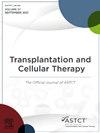与肠向性病毒表位交叉反应的次要组织相容性抗原促进急性肠道GvHD
IF 3.6
3区 医学
Q2 HEMATOLOGY
引用次数: 0
摘要
急性胃肠道(GI) GvHD的严重表现预示着同种异体hct后预后不良。因此,迫切需要新的工具来预测——并可能减轻——GI aGvHD风险。在hla匹配的同种异体hct中,T细胞的同种异体反应性是针对次要组织相容性抗原(mHAgs)的,为了鉴定mHAgs,我们之前已经开发了一个基于供体-受体(D-R)对种系DNA全外显子组测序(WES)多态性检测的分析框架(Cieri, Nat biotechnology 2024)。根据临床观察,病毒的再激活往往与GvHD的发展相一致,我们假设mHAgs与肠道病毒表位(ADV、CMV和EBV)的序列同源性可能有助于GI aGvHD的病理生理。为了量化跨患者特异性mHAg图谱的交叉反应程度,从UniProt检索ADV、CMV和EBV的完整病毒蛋白质组,用计算机创建所有可能的8-11mers (n = 1,108,265),然后对其进行HLA I类表位预测,得到包含129个HLA I类等位基因的195,081个病毒表位目录。从520对hla匹配的D-R对(220对MRD, 300对URD)的WES分析中预测的mHAgs首先过滤GI非造血细胞中的表达,并通过健康和移植后个体GI组织的单细胞RNASeq数据集进行鉴定。与预测病毒表位的同源性通过以下方法确定:(i)滑动窗口,即mHAg与病毒抗原共享≥6个连续氨基酸;或(ii)跳过窗口,即mHAg与病毒抗原之间的Levenshtein距离≤2个氨基酸,与位置无关。预测的mHAgs只有在与相同HLA限制下呈现的病毒表位具有同源性时才被认为具有交叉反应。在MRD队列中,交叉反应性gi特异性mHAgs的中位数为37(范围:13 - 87)。发生严重GI aGvHD (III-IV级)的患者比没有发生的患者具有更高的GI特异性交叉反应mHAgs负荷(P = 0.038)。我们考虑了诊断、预后风险评分、移植状态、调节方案、移植物来源、供者年龄和CMV状态对中位交叉反应性mHAg负荷对GI aGvHD风险的影响。只有交叉反应的mHAg负载>;中位数与发生严重GI aGvHD的风险增加相关(HR = 4.96,95% CI: 1.13 - 19.44, P = 0.03)。对300对hla匹配的URD -r对独立队列的初步分析证实了交叉反应性mHAg负荷与严重GI和GvHD之间的关联(P = 0.018)。我们的研究结果揭示了对肠道病毒的交叉反应性是GI aGvHD病理生理的关键因素。通过分子表征D-R对来量化交叉反应性,为移植前预测提供了一个很有前途的工具,可以促进高风险患者的预防策略(如vedolizumab)的结合。本文章由计算机程序翻译,如有差异,请以英文原文为准。
Minor Histocompatibility Antigens Cross-Reactive Against Gut-Tropic Viral Epitopes Facilitate Acute GvHD of the Gut
Severe manifestations of acute gastrointestinal (GI) GvHD portend a poor prognosis after allo-HCT. Therefore, new tools to predict – and possibly mitigate – GI aGvHD risk are urgently needed. In HLA-matched allo-HCT, T cell alloreactivity is directed against minor histocompatibility antigens (mHAgs), for the identification of which we have previously developed an analytic framework based on polymorphism detection by whole exome sequencing (WES) of germline DNA from donor-recipient (D-R) pairs (Cieri, Nat Biotechnol 2024). Building on the clinical observation that viral reactivations often coincide with the development of GvHD, we hypothesized that sequence homology of mHAgs with gut-tropic viral epitopes (ADV, CMV and EBV) may contribute to GI aGvHD pathophysiology.
To quantify the extent of cross-reactivity across the patient-specific mHAg landscape, complete viral proteomes for ADV, CMV and EBV were retrieved from UniProt to create in silico all possible 8-11mers (n = 1,108,265) that were then subjected to HLA class I epitope prediction, resulting in a catalog of 195,081 viral epitopes across 129 HLA class I alleles. Predicted mHAgs from WES analysis of 520 HLA-matched D-R pairs (220 MRD, 300 URD) were first filtered for expression in GI-resident non-hematopoietic cells, as identified by single cell RNASeq datasets of GI tissue from healthy and post-transplant individuals. Homology with predicted viral epitopes was defined by either: (i) sliding window, i.e., mHAg and viral antigen sharing ≥6 consecutive amino acids; or (ii) skipping window, i.e., Levenshtein distance between mHAg and viral antigen ≤2 amino acids, irrespective of position. Predicted mHAgs were considered cross-reactive only if displaying homology with viral epitopes presented on the same HLA restriction.
Across the MRD cohort, the median number of cross-reactive GI-specific mHAgs was 37 (range: 13 – 87). Patients who developed severe GI aGvHD (grade III-IV) had a higher load of cross-reactive GI-specific mHAgs than patients who did not (P = 0.038). We considered the impact of diagnosis, prognostic risk score, status at transplant, conditioning regimen, graft source, donor age and CMV status against median cross-reactive mHAg load on risk for GI aGvHD. Only cross-reactive mHAg load > median was associated with increased risk of developing severe GI aGvHD (HR = 4.96, 95% CI: 1.13 – 19.44, P = 0.03). Preliminary analysis of an independent cohort of 300 HLA-matched URD D-R pairs confirmed the association of cross-reactive mHAg load with severe GI a GvHD (P = 0.018).
Our findings reveal cross-reactivity against gut-tropic viruses as a key contributor to GI aGvHD pathophysiology. Molecular characterization of D-R pairs to quantify cross-reactivity provides a promising tool for pre-transplant prognostication that could facilitate the incorporation of preventative strategies (such as vedolizumab) in high-risk patients.
求助全文
通过发布文献求助,成功后即可免费获取论文全文。
去求助
来源期刊

Transplantation and Cellular Therapy
Medicine-Hematology
CiteScore
7.00
自引率
15.60%
发文量
1061
审稿时长
51 days
 求助内容:
求助内容: 应助结果提醒方式:
应助结果提醒方式:


